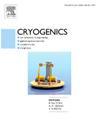Experimental and simulation study of LN2 active-pressurization in onboard LH2 storage and supply systems
IF 1.8
3区 工程技术
Q3 PHYSICS, APPLIED
引用次数: 0
Abstract
To prevent insufficient pressure within the onboard LH2 storage tank during supply, which could lead to significant residual LH2 that cannot be supplied, the design of the onboard LH2 storage and supply system needs to consider the active-pressurization method of the LH2 tank. To investigate whether the active-pressurization method can meet the active-pressurization performance requirements for low-temperature fluids in onboard LH2 storage tanks, this study uses LN2 as the working fluid. Experiments on active-pressurization and supply in the onboard LH2 storage system were conducted, exploring the impact of different LN2 fill levels on the active-pressurization rate and the pressure stability during the active-pressurization supply process. Based on the parameters of the LH2 tank, a system simulation model was established. The maximum active-pressurization flow rate of the simulation model was calibrated according to the active-pressurization experimental data, further exploring the active-pressurization storage and supply characteristics of the onboard LH2 tank. The results indicate that the active-pressurization supply simulation results, calibrated with the active-pressurization flow rate, show good consistency with the experimental data. As the supply flow rate increases, the active-pressurization maintaining pressure slightly decreases. When the liquid level drops too low and transitions to gaseous supply, the pressure inside the tank rapidly declines. At an ambient temperature of −10 °C, the active-pressurization can still offset the pressure drop caused by the supply. However, higher ambient temperatures increase the temperature difference during, leading to a higher evaporation rate inside the tank. The active-pressurization flow rate was corrected by the ratio of the densities and viscosities of LN2 and LH2 to investigate the situation of active-pressurization to exceed the critical pressure. When the LH2 tank is actively pressurized to the critical pressure, there is still a return gas temperature difference close to 170 K, which is much higher than the 0 K of LN2, thereby promoting the active-pressurization rate. This study explored the active-pressurization capability and influencing factors of onboard LH2 storage tanks through LN2 experiments and system simulation methods, providing a foundation for precise control of the active-pressurization supply in onboard LH2 systems.
机载LH2储运系统中LN2主动增压的实验与仿真研究
为了防止在供给过程中机载LH2储罐压力不足,导致大量剩余LH2无法供给,机载LH2储罐供给系统的设计需要考虑LH2储罐主动增压方式。为了研究主动增压方法是否能满足机载LH2储罐低温流体主动增压性能要求,本研究采用LN2作为工作流体。对机载LH2存储系统进行了主动增压与供给实验,探讨了不同LN2填充水平对主动增压速率和主动增压供给过程中压力稳定性的影响。根据LH2罐的参数,建立了系统仿真模型。根据主动增压实验数据,对仿真模型的最大主动增压流量进行了标定,进一步探讨了机载LH2油箱主动增压储运特性。结果表明,采用主动增压流量标定的主动增压供气仿真结果与实验数据具有较好的一致性。随着供给流量的增加,主动增压维持压力略有降低。当液位下降过低,过渡到气体供应时,罐内压力迅速下降。在环境温度为- 10℃时,主动增压仍然可以抵消由供电引起的压降。然而,较高的环境温度增加了过程中的温差,导致罐内蒸发速率更高。利用LN2和LH2的密度和粘度之比对主动增压流量进行校正,考察主动增压超过临界压力的情况。当LH2罐主动增压至临界压力时,仍有接近170 K的回气温差,远高于LN2的0 K,从而促进了主动增压速率。本研究通过LN2实验和系统仿真方法,探索了机载LH2储罐的主动增压能力及其影响因素,为机载LH2系统主动增压供给的精确控制提供了基础。
本文章由计算机程序翻译,如有差异,请以英文原文为准。
求助全文
约1分钟内获得全文
求助全文
来源期刊

Cryogenics
物理-热力学
CiteScore
3.80
自引率
9.50%
发文量
0
审稿时长
2.1 months
期刊介绍:
Cryogenics is the world''s leading journal focusing on all aspects of cryoengineering and cryogenics. Papers published in Cryogenics cover a wide variety of subjects in low temperature engineering and research. Among the areas covered are:
- Applications of superconductivity: magnets, electronics, devices
- Superconductors and their properties
- Properties of materials: metals, alloys, composites, polymers, insulations
- New applications of cryogenic technology to processes, devices, machinery
- Refrigeration and liquefaction technology
- Thermodynamics
- Fluid properties and fluid mechanics
- Heat transfer
- Thermometry and measurement science
- Cryogenics in medicine
- Cryoelectronics
 求助内容:
求助内容: 应助结果提醒方式:
应助结果提醒方式:


